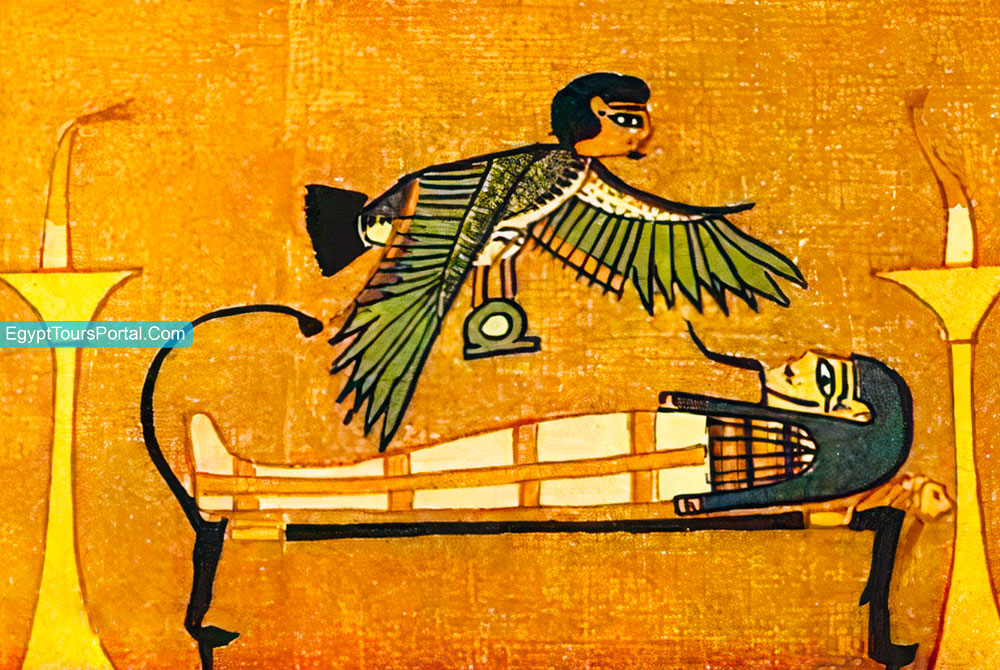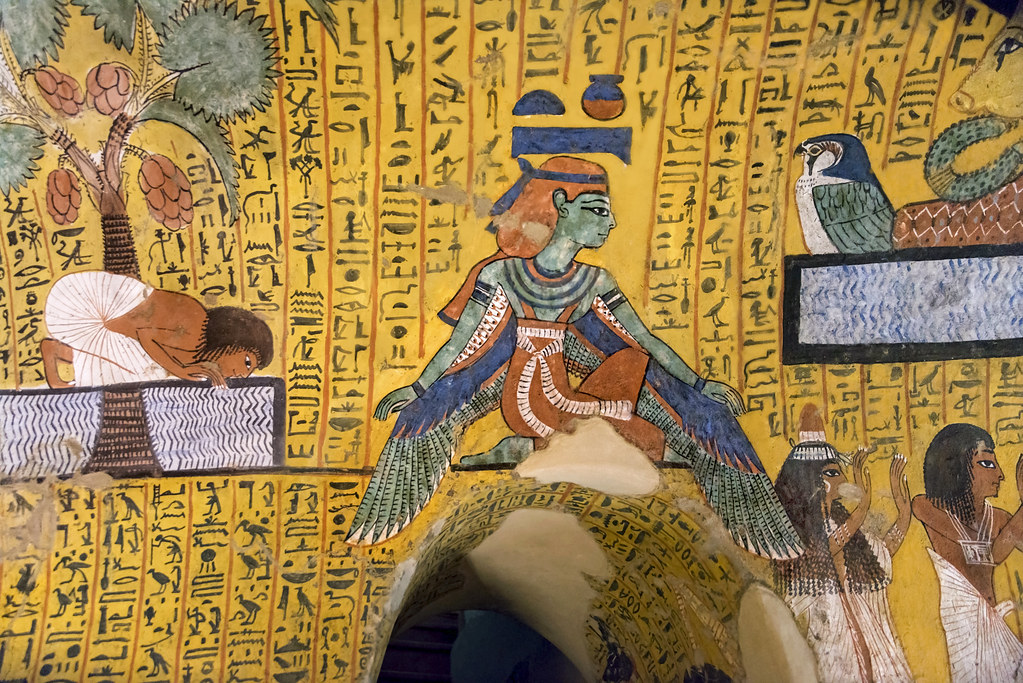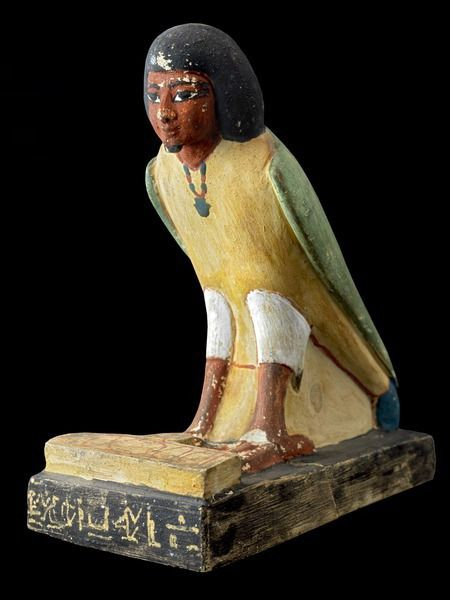3 Elements to the Egyptian concept of the soul: Ka, Ba, and Akh .___ ((Ka)) is the life force or spiritual double of the person. The royal Ka symbolized a pharaoh’s right to rule___((Ba)) is represented as a human-headed bird that leaves the body when a person dies.___((Akh)) was a concept of the dead that varied over the long history of ancient Egyptian belief, was associated with thought, but not as an action of the mind; rather, it was intellect as a living entity.

Our topic in this article is the Ba, the master of soul and body, and we have the chance to read an excellent interview by Marie Grillot with brilliant Michèle Juret and an introduction of her book about the secret of this bird and all we can get to know about it.

“The ba-bird, second life in ancient Egypt”: the new work by Michèle Juret
via: égyptophile

TT 359 – Deir el-Medina – 20th dynasty – Ramses III Ramses IV
“The ba-bird, Second Life in Ancient Egypt” by Michèle Juret – published by Books on Demand
A graduate of the École du Louvre and curator of the Montgeron Museum, Michèle Juret is notably “the” biographer of the Egyptologist Etienne Drioton, the last French director of the Egyptian Antiquities Service.
With her new publication: “The Ba-bird, Second Life in Ancient Egypt”, she devotes herself to a theme that is particularly dear to her since it was, from 2002, the subject of her research dissertation. Driven by her interest and passion for this entity flying “between two worlds”, she has never stopped researching and “taming” its multiple and diverse representations… Evoked in several chapters of the “Book of the Dead”, the ba-bird is found on the walls of tombs, on coffins, papyri, steles, statues, offering tables, or even on pectorals and amulets…
As meticulously as it is applied, this well-documented study allows us to understand better this conception of “ba” so intimately – and specifically – linked to ancient Egypt…

Michèle Juret, author of “The Ba-bird, Second Life in Ancient Egypt”
published by Books on Demand in May 2022
MG-EA: To understand what a “ba-bird” is, we must certainly first understand the importance of this “ba” entity in the conception of the personality of the ancient Egyptians.
Michèle Juret: First of all, I would like to thank you, Marie Grillot, for this interview, which allows us to discuss the essentials of this work, namely the observation of the iconography of the ba in the light of the funerary texts.
As you say, it is first necessary to understand the importance of this fundamental entity, a guarantee of survival.
For the ancient Egyptians, the individual is made up of various elements:
The body, immobilized by death, will remain in the grave.
Ka, the vital force, draws its energy from food.
The Akh, celestial spirit, magical power, can be beneficial or evil.
The shadow will enjoy a certain independence.
We commonly translate the ba by the word soul, although the concept is much more complex. An important element is that it is of divine nature. The Alter-ego of the deceased is essential to his survival.
MG-EA: The ba-bird generally presents itself as a composite, anthropo-cephalous being, that is to say, with a human head and a bird’s body: when did it appear, in this form, in the iconography?
Michèle Juret: This half-avian/half-human appearance is the culmination of a slow evolution. From the Old Kingdom, the king’s ba, named in the Pyramid Texts, appears in hieroglyphic writing as a wader with a loop at the base of the neck. In Middle Kingdom texts, it is seen as a bird with the head of the living (human) without this image appearing in the writing. Finally, some amulets and masks decorated with feathers date from this period, and then the rishi sarcophagi will become milestones towards this figure of an anthropo-cephalous bird that we will commonly encounter from the New Kingdom onwards.

TT 290 – Deir el-Medina – 19th dynasty – Ramesses II
MG-EA: Indispensable to the survival of the being that death has immobilized the ba-bird, he enjoys total freedom… He can enter and leave the grave in, you write, “a moving interdependence with the deceased”? He thus becomes the guarantor of his “post-mortem” future?
Michèle Juret: Indeed, Le ba enjoys total freedom. He will be able to leave the tomb, climb into Ra’s boat, benefit from its rays, drink the regenerating water of the tree goddess, benefit from the food offerings… Every evening, he will rejoin the body of his deceased; their survival depends on their reunion… Observing this iconography transports us into an almost magical world. We follow the entity in its daily comings and goings, alone or accompanying its deceased, maintaining its own life through food offerings or providing this food for the deceased’s ka. Finally, it unites with it in an interdependent guarantee of survival.
MG-EA: Evoked and invoked in several chapters of the Book of the Dead, associated with the cycle of the sun, it is itself endowed with several “becomings”?
Michèle Juret: Yes, in fact, several futures are possible for him. We have just mentioned the best and most probable, the second life as an alter-ego of the deceased. Let us remember that the post-mortem fate of the ancient Egyptians is complex. A solar destiny will allow him to follow Ra in his boat or a stellar one among the stars, and finally, an Osirian destiny will allow him to cultivate the fields of Ialou. How can we reconcile these notions, which seem contradictory? The ba-bird becomes the answer to this question and the link between these different post-mortem futures. His destiny is divine.
But he could be led towards another destiny linked to that of the heart, a very important element.
The texts also evoke the presence of the ba at the weighing of the heart, a scene of judgment also called psychostasis. In chapter 125 of the Book of the Dead, it is attested through Thoth’s words: “I have examined the heart of Osiris Ani while his ba presents himself, stands as a witness about him…” In the vignette from this papyrus, we see the ba-bird witnessing this judgment. Its future is linked to that of the heart. The Book of Caves gives a version of its annihilation if the heart is declared guilty. While this would be separated from the deceased and thrown into one cauldron, the ba and the shadow would be thrown into another. The deceased would be among the damned, those who no longer have a soul. Like that of the body, the destiny of the ba is linked to that of the heart key of life.

servant of the Place of Truth – TT 219 – Deir el-Medina – 19th dynasty
MG-EA: Your research, targeted on the “ba-birds” of individuals from the New Kingdom, was based on a vast literature and the study of numerous of their representations: their iconography is rich and evolving, and the location where they take place, always full of meaning?
Michèle Juret: Yes, as you say, these representations are loaded with meaning. It was important to bring the iconography closer to the funerary texts. There, we find the reading keys. The analysis of the documentation fully reflects the different situations they express. Furthermore, the location of certain scenes on the tombs’ walls was not chosen randomly but determined according to the theme evoked.
MG-EA: You not only studied their adornments and hairstyle, but to refine their description and relate them to existing species, you also had to develop ornithological talents?
Michèle Juret: Ornaments and hairstyles allowed me, in some instances, to put forward a possible desire to identify with the deceased.
Furthermore, observing the bodily appearance of these birds, another aspect of this study, highlighted different options in the choice of species depending on the chapters of the Book of the Dead that they illustrate. This observation proved fascinating, and I ventured to put forward some hypotheses. Unfortunately, I didn’t have the “ornithologist talents” you mentioned. A specialist from the Natural History Museum helped me a lot with this identification.

TT 159 – Dra Abou el-Naga – 19th dynasty
MG-EA: Would you not be tempted, now, to take an interest in the “ba-birds” of the pharaohs and queens?
Michèle Juret: Obviously, it’s a subject that also deserves to be addressed. In this study, I was tempted to quickly evoke the ba-bird of Tutankhamun and especially that of Queen Nefertari, an extraordinary example. On the one hand, its extremely composite body appearance combines both falconiform and anseriform characteristics, two birds with solar connotations. On the other hand, its profile, resembling that of the queen and its crown, the remains of a vulture surmounted by the modius, reinforce this idea of a desire to identify the ba-bird with its deceased.

TT 66 – Deir el-Medina – 19th dynasty – Ramesses II
This iconography fully reflects the importance of the ba in the Egyptian’s concerns for his post-mortem future. It will also be able to completely replace itself and become, in its place, as a substitute, the active element. Survival is in him. This is perfectly expressed on the stele of Neferhotep, which caught the attention of Etienne Drioton…
Comments collected by Marie Grillot
Michèle Juret, The ba-bird, second life in ancient Egypt.”
188 pages – Publisher: Books on Demand
Publication date: 12.05.2022 https://www.bod.fr/librairie/loiseau-ba-michele-juret-9782322420131?fbclid=IwAR1z_prPOSx43ielkTm-o03OaqR-FWrdg6Ky9eBk1Zdyh1eOqSVOI0NMiuU
Published 6th October 2022 by Marie Grillot


🧡🐦
LikeLiked by 1 person
Merci!💖🙏
LikeLike
This is a magnificent post! And so informative and educational!
LikeLiked by 1 person
Thanks a lot, dear friend. It’s most inspiring. 👍🙏✌️
LikeLiked by 1 person
You’re very welcome!
LikeLiked by 1 person
Those interesting birds who were whisked away for a second life. This is fascinating.
LikeLiked by 2 people
Indeed, my dear Chris. The birds of life and death!🤗🙏
LikeLiked by 1 person
Wonderful images. I’ve always found the Ba Bird and Ka bird fascinating and mysterious, but at the same time explanatory of the human soul. Thank you for helping me understand more.
LikeLiked by 1 person
All of these mysteries from Egypt continue to amaze me, and we can always learn something new. Thank you, Elaine, you are highly appreciated.
By the way, I couldn’t reach your site yesterday, but today it is OK again. I just wondered if you noticed any problem yesterday?!
LikeLiked by 1 person
We’ve had many problems with downed phone and internet lines because of fierce winds. This is rare here, but climate change is upon us. I didn’t have electric power for two days, but at the moment all is well and I think all messages are coming through. Be well.
LikeLiked by 1 person
Yes, everything is working fine now. Take care. 💖
LikeLike
This is fascinating.
Bird-ba of Youya is definitely a piquing statuette.
Man’s belief in some form of life after death seems one of the only constants in religions and their philosophies.
The Egyptian are fascinating. Love these articles. Thank you, Alaedin!
👏🥰🤗💖
LikeLiked by 1 person
Well explained, my dear Resa. Who knows what is behind all these secrets. 😉🙏❤️🙏🙏💖
LikeLike
Insightful information of the terms Ka, Ba, and Akh – the photos are also interesting!
LikeLiked by 1 person
Much appreciated! Thank you for dropping by.🙏🤙
LikeLiked by 1 person